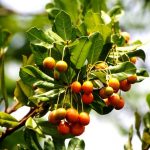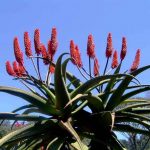TREE LIFE
April 1985
MASHONALAND CALENDAR
Tuesday April 2nd: Botanic Garden Walk. Meet in the Car Park at 1645 for 1700 hours for a stimulating, sociable and entertaining evening’s stroll in the garden.
Sunday April 21st: A visit to the Henry Hallam dam area. Despite being wedged between the Harare and Chitungwiza complexes the woodland on the north side of the dam and the Hunyani is in a remarkably well protected state. This is the result of municipal police patrols to guard against unlawful wood cutting. Downstream a fine woodland stretches for several kilometers and the musasas are of extraordinary stature. We plan to spend the morning walking through this and then have lunch at the picnic site below the dam wall; a pleasant spot with an ablution block which we hope to arrange to have open for the occasion. This area has a rewarding variety of woodland and riverine trees including Olea europea var. africana.
No bus has been arranged as the short distance will make this quite uneconomical. We will meet at 0900 hours in the car park at the Monomatapa Hotel to share transport. As usual a security guard will be on hand to safeguard the cars left behind.
MATABELELAND CALENDAR
Due to the Easter Holiday our next meeting will be on Sunday 14th April at the Fortunes Gate turn off, from the Essexvale Road, for part of the Circular Drive.
On Sunday March 10th we met at Mr. Sykes’ house for part of the Helensvale Block, near the Big Albizias.
We listed some 54 trees, but access was a bit restricted owing to the long grass in some parts, so I think we did quite well.
We saw Acacia nigrescens, Albizia amara and Albizia antunesiana, this last being a big tree, so that many said they had not seen a bigger Albizia. Bridelia mollis, Canthium huillense, now C. lividium, Canthium lactescens, Cassine matabelica, Clerodendrum glabrum, Combretum apiculatum, Combretum hereroense, Combretum molle, Commiphora africana, Commiphora mossambicensis, Croton gratissimus, Cussonia natalensis, Dalbergia melanoxylon, Dichrostachys cinerea, Diplorhynchus condylocarpon, Dombeya rotundifolia, Erythrina latissima, Euclea divinorum, Euphorbia ingens, Ficus ingens, Ficus sonderi, Flacourtia indica, Gardenia volkensii, Grewia flavescens, G. monticola, Kirkia acuminata, Lannea discolor, Lippia javanica, Maytenus heterophylla, Mundulea sericea, Maytenus senegalensis, Ozoroa reticulata, Pappea capensis, Pavetta gardeniifolia, Pavetta schumanniana, Pouzolzia hypoleuca, Pseudolachnostylis maprouneifolia, Pterocarpus angolensis, Rhus leptodictya, Tarchonanthus camphorates, , Tarenna neurophylla, Terminalia sericea, Turraea nilotica, Vangueria infausta, Vitex payos, Ximenia caffra, Ziziphus mucronata.
BOTANIC GARDEN WALK, MARCH 1985
The classification system we have been following lately is that of Cronquist, the curator of the New York Botanic Gardens. His scheme is very similar to that proposed by the Russian botanist, Dr. Armen Takhhtajan. In this system the dicotyledons are divided into six sub-classes. In this walk we looked at most of the indigenous representatives within one of these sub-classes; the Hameliidae.
To explain :
Division : Angiosperms or flowering plants, in contrast to the ferns of the conifers
Class : Dicotyledons usually with net veins, in contrast to monocots with parallel veins
Sub-class : Hamamelidae, with three indigenous orders :
Order 1 : Hamalidales containing the family HAMAMELIDACEAE
Order 2 : Myricales containing the family MYRICACEAE
Order 3 : Urticales with three families : ULMACEAE, URTICACEAE AND MORACEAE
If we neglect the last order for the moment, this leaves us with two orders, two families and a total of four indigenous tree like species, which form real representatives of the Hamamelidae. This is remarkable because if we were to discuss the trees of Europe or North America, then many of the trees fall in the core of the Hamamelidae, including the plane, witch hazel, walnut, beech, oak, birch, hickory and hazel. These trees are typical of the group and generally have wind pollinated flowers without petals. The flowers are small, unisexual, and grow in catkins. Wind pollinated trees are poorly represented in our flora, probably due to the wealth of insects and birds available to perform the job even better.
The central family within the sub class is the HAMAMELIDACEAE represented by the indigenous witch hazel, Trichocladus ellipticus subsp. malosanus. Exotic members of the family include the European witch hazel, Hamemalis, noted for flowering either in late autumn or very early spring while the snow is still on the ground, and the garden tree, Liquid amber, grown for its red autumn leaves. The deciduous, palmately lobed leaves of Liquid amber don’t seem similar to the simple, entire leaves of Trichocladus, except that both have star like tufts of rust coloured hairs on the leaf under surface. These hairs often characterize the HAMAMELIDACEAE and are referred to as a stellate indumentums. Tom Muller describes the attractive perfume from the bunches of small yellow flowers of Trichocladus. The specimen we saw in the gardens was collected by Trevor Gordon from Mt. Gorongoza where large bushy trees grow along rivers and forest edges in places where the canopy opens up enough to allow more light to penetrate into the rain forest. This specimen has not seeded well, but layering has proved most successful. Gill Masterson collected a specimen from a hillside north east of Harare which Bob identified this Trichocladus, this is the first record of it growing this far west and is most exciting.
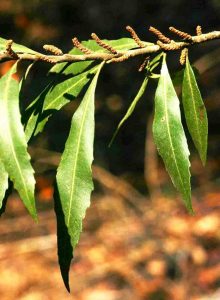
Myrica serrata. Photo: Bart Wursten. Source: Flora of Zimbabwe
The scented flowers of Trichocladus indicate insect pollination, the tendency towards wind pollination in the rest of the subclass comes with a total reduction in the flowers and the development of catkins as in the MYRICACEAE. The unisexual flowers are individually inconspicuous and grow together in stubby catkins as Tom showed us on Myrica serrata, a lanceolate leaved tree commonly seen along river banks on the Highveld particularly the Mazowe River. The leaf margin is toothed or serrated as are those on the small leaved M. microbracteata, a shrubby tree endemic to Nyanga. In both of these species the leaf blade gently tapers into the short petiole, unlike M. pilulifera, which Tom has growing at the top of the new stream. In this species a definite petiole exists. The genus Myrica is commonly referred to as the waxberry as the fruits develop a waxy bloom which may be extracted with boiling water. The MYRICACEAE have simple leaves arranged in a spiral and are characterized by having small but conspicuous silver or gold scales on the leaf under surface. These scales are each shaped like a flat topped mushroom and produce a resinous odour. MYRICACEAE roots commonly bear nodules that harbor bacteria which can make atmospheric nitrogen available to the plant.
The last of the orders we saw was the Urticales consisting of the ULMACEAE, URTICACEAE and MORACEAE. There is little doubt that these families are closely related to one another, but it is not certain whether they fit more naturally in the Hamamelidae or alongside the Malvales in another of the sub classes. The overall scheme would not be upset by having them in either position. For the moment we will look at the ULMACEAE and see how they are similar to the URTICACEAE, and then tie the URTICACEAE in with the MORACEAE, or fig family. Generally the Urticales have simpile, alternate leaves with pinnate serration although they may be both pinnate and palmate at the same time. This condition is known as pinnipalmate venation and is represented in the Ulmaceae by Trema orientalis and Celtis africana where the 3 main veins originate from an oblique base with unequal lobes. T. orientalis is a fast growing pioneer tree in moist soils and has serrations the whole way around the leaf margin, whereas in C. africana the lower third of the leaf margin is entire. Seeds of C. africana are widely dispersed by birds and grow well amongst rocks and along river banks. In the evergreen forests around Mt. Selinda C. gomphophylla grows into a forest giant developing a buttressed trunk. Although the leaves are entire and not pinnipalmate the branches look similar to those of the C. africana; the leaves of the Ulmaceae grow in two ranks along the branch which is often held almost horizontal; as a result the leaves do not shade one another. Tom reports that C. gomphophylla can develop a smell comparable with an open latrine. Although they are deciduous they have a very fast leaf change. Both C. comphophylla and C. africana have a purple speckled slash pattern, the slash of Trema is very white. The leaves of both these species of Celtis and those of Trema are coated in fine hairs which give the leave an abrasive texture. Such hairs are a common feature throughout the Urticales, think of the sandpaper figs, although they are absent in C. mildbraedii, an uncommon tree also of the Eastern Districts rain forests. In Mozambique C. mildbraedii grows into a 55 m giant with a circumference of 4 -5 meters. The slash pattern consists of concentric rings of purple and white, not speckled as in the other species.
Alongside Ocotea kenyensis off the Anthocleista lawn Tom showed us a most unusual Ulmaceae, Chaetacme aristata of the drier forests around Mutare and Zimbabwe Ruins. The branches bear sharp spines and the leaves are thickly leathery and covered in a cuticle which crackles as the leaf is bent. The leaf base is not oblique and the tip of the leaf has a long hair like bristle, which is referred to in the name ‘aristata’. We noted the female flower which is like the other Ulmaceae with an almost naked ovary. The two ranked leaves along the zig zag branches are fleetingly reminiscent of Trema. In addition, when the leaf is held up to a strong light and examined with a hand lens, fine pellucid dots may be seen. These are formed by a concretion of calcium carbonate within the cells are called cystoliths. These dots must not be confused with those of the RUTACEAE which are glandular and exude volatile oils. The best indigenous cystoliths may be seen in the URTICACEAE.
The URTICACEAE are not true trees, although a number do develop into overgrown shrubs with fibrous stems, such as the tree stinging nettle, Obetia tenax. We more frequently encounter Pouzolzia mixta, the new name for P. hypoleuca, which also has hairs although they do not sting. Tom was proud to show us a specimen of Boehmeria, B. platyphylla a shrubby plant which does not sting but has the hairs of the URTICACEAE and long hanging catkins. This plant has very large cystolths and the leaves are decidedly three to five veined from the base. Another family feature with the URTICACEAE was immortalized by H.C Anderson, where in the tale of the wild swans Elisa is expected to pluck stinging nettles and trample them to produce a yarn with which to break a spell placed upon her eleven brothers. Fibers are obtained from many of the nettle family, certainly from our indigenous genera. One species of Boehmeria produces “perhaps the longest, toughest and most silky of all vegetable fibers” (Willis 1951) and another species produces “ramie” a durable fiber. It is this feature of the URICACEAE which links in well with the hemp plant, Cannabis sativa, better know and grown locally as dagga. Dagga is now placed in a small family with Humulus, the source of hops for beer, but they were both within the MORACEAE, in any case they are closely related to the MORACEAE. This relationship also demonstrates that palmately compound leaves, as in dagga, are not that unusual in the Urticales, this helps to relate the indigenous Myrianthus in the MORACEAE to the rest of the order. Myrianthus has palmate leaves which initially seem out of place so close to the figs.
Tom also covered the LOGANIACEAE in the same botanic garden walk, if I have time I will write this up for another time. In passing we noted a large Albizia gummifera which suffered badly from a bacterial (?) bark rot. This same disease has also struck a Kyaha and a Chlorophora in the gardens and was identified as a rotting smell around the tree. Much of the bark has been removed and the tree has been treated. It is surprising to see how little bark a tree really needs in order to go on living. We must thank Tom for sharing more of the garden with us.
-Kim ST.J. Damstra.
OUTING AND AGM AT DANBURY PARK, MT. HAMPDEN AREA, 17TH MARCH 1985
Tom and Bobs Bayley were our hosts at Danbury Park on the Old Mazowe road. Here we interrupted a most pleasant day’s treeing to hold our AGM at noon. The minutes of the AGM will be published in due course, but meanwhile the composition of the elected Committee, is as follows :
Vice Chairman (and temporarily Acting Chairman) Mr. Kim Damstra
Treasurer Mrs. Joy Killian
Secretary Mrs. Marjorie Barker
Minute Secretary Mrs. Meg Coates Palgrave
Committee members Molly Kilpert, Pat Walker, Barbara Browning,
Georgie Granelli, Margaret Bennett, Philip Haxen
The glaring omission of a Chairman is not an error. The simple point is that there were no takers for this post. It is hoped that this will be a temporary problem. There are possibilities which may materialize.
The outgoing Chairman thanked outgoing Brian Best for his diligent service over the last three years as Treasurer; George Hall, who stood down after many years on the Committee and Father Ross who had served on the Committee during the past year. The Chairman’s report is included in this edition of Tree Life.
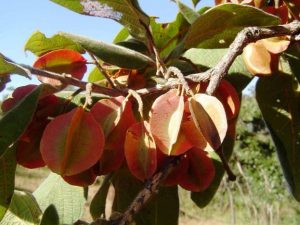
Combretum molle. Photo: Bart Wursten. Source: Flora of Zimbabwe
After the meeting our hosts in the morning, and downing welcome cups of tea, we braved the drizzle, which soon dried up, and headed once more for the memorable Wishing Tree. We soon encountered the first of many Combretum molle, bearing four winged fruit and velvet soft leaves. At some points on the walk this tree was dominant.
Against the wall of the cattle dip grew a young Ficus thonningii, bearing small fruit in the axils of the leaves rather than on the main stem or branches. This strangler fig was vividly demonstrated on the next specimen, an individual which had so embraced a Parinari curatellifolia that the bark of the Parinari was only visible through odd chinks in the lace work of intertwining roots. The most remarkable example of F. thonningii though, was the Wishing Tree at the summit of the low kopje which we ascended.
Here one sees two trees rooted in the ground but sharing a common branch overhead. Like Siamese twins, or is it one tree with two trunks and an arch way in between through which one may walk and make a wish. Were these two trees welded together or was it one strangler that sent two different roots down two different roots down two separate but touching trees?
A small tree was shown to be Cassia singueana by virtue of the protruding ‘bee sting’ gland between each pair of leaflets. New members were also introduced to Ziziphus mucronata with the unmistakable thorn arrangement – one pointing forward and the other curing backwards. The symmetric leaf with three veins from the base is also helpful.
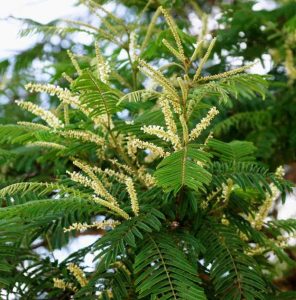
Acacia polyacantha. Photo: Bart Wursten. Source: Flora of Zimbabwe
Four finely leafed trees were compared. Two had thorns which pointed the way to Acacias. Both were young and had flaking bark, but one had hooked thorns and the other straight thorns, these were A. polyacantha and A. sieberiana respectively. A very fine leafed tree without thorns was Albizia amara. The fourth also thornless, but with slightly larger leaflets was Peltophorum africanum. This tree has more erect and sometimes yellow green leaves.
A large Ekebergia provided fuel for debate; was it E. benguelensis or E. capensis. The “look” did not seem to fit either. The petioles etc. lacked the usual pink of E. banguelensis although this is what it was proved to be, determined by the thick rough bark on the branchlets, a feature not shared by the other species.
Further up the hill, Pittosporum viridiflorum was identified by the dark lenticels on the otherwise pale grey bark.
Two unusually large Euclea divinorum were seen and were notable as neither was growing on an anthill, as is more typically the case, which may suggest a good underground water supply. This was possibly confirmed by a large Celtis africana which also enjoys a moist soil.
Near the top of the hill we encountered Maerua angolensis, commonly known as the bead bean, due to the constrictions between each seed in the long narrow pod. We were lucky to see a few of these pods and were shown the ‘collar’ half down along the pod stalk which represents the remains of the petals of the flower. The extended stalk or androgynophore, beyond this is characteristic of the family, the CAPPARACEAE, see Tree Life 57. The long petiole, holding a simple roundish leaf, is striking. It is every bit as long as the leaf itself.
After our AGM and a lazy lunch on the lawn, we headed out along the main road for a couple of kms to our afternoon venue, another low kopje which had been decimated by prospectors over five decades ago and was now in a healthy state of regeneration.
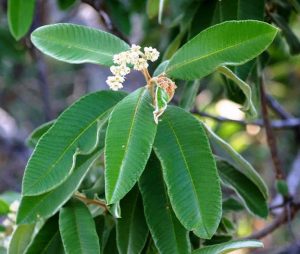
Ozoroa insignis. Photo: Bart Wursten. Source: Flora of Zimbabwe
We passed an Ozoroa insignis complete with ‘raisins’ or ‘tar berries’ which while looking tasty enough are quite inedible. Further along our route we came to a group of Uapaca kirkiana, the mahobohoba or muzhanje. The individual we first examined was a male in full flower. This tree is dioecious meaning separate sexes and separate trees. So no fruit is found on the male tree. The large hard leaf of this tree is the unmistakable growing tip or bud makes the tree easy to recognize.
Close by was a group of Psorospermum febrifugum. Christmas berry or Zimbabwe holly, so called, it is unrelated to true holly, as a result of the red berries which put on a fine display on the specimens we saw. The opposite leaves and the rusty orange undersides of the leaves are useful pointers.
Three trifoliate, compound with three leaflets, leafed trees were seen – Rhus longipes has a smooth texture and roundish leaves with an entire margin. The smell of the crushed leaf was noted and used to help separate R. tenuinervis from Allophylus africanus which both have a scalloped margin to the leaf and a velvety texture. Allophylus though is supposed to have those ‘hairy armpits’ in the axil of the veins and spherical fruit rather than the flattened fruit of Rhus.
The ubiquitous but ever variable Flacourtia indica made its appearance showing pink petiole and midrib, and fairly typical scalloped margin on this occasion. Alec Day pointed out useful feature worth looking out for in future that is the diamond shaped leaf.
Several representatives of the RUBIACEAE family were seen in rapid succession. This family is characterized by opposite leaves and interpetiolar stipules. This latter structure is found between the base of the two leaves on either side of the stem. In some species, e.g. the Gardenia volkensii, Pavetta gardeniifolia displayed its black dots in the leaves when held up to the light. The smooth glabrous leaf make it P. gardeniifolia rather than P. schumanniana which we also saw moments later. We could then see the ‘quilted’ texture and felt the hairy surface on the leaf. A more unusual find was Tapiphyllum velutinum. The specific name refers to the soft velvety leaf. Another feature was the manner in which the branches are held in horizontal planes.
Of the number of other trees, I recall Steganotaenia araliacea as there were so many of them about. This is the ‘pop gun’ tree, so called because children can push out the centre of a stem leaving a hollow tube. The centre part can be used as a plunger which will blow out a ‘cork’ at the other end. The margins of the leaflets are highly serrated, the tip of each serration almost becomes a short thread. This tree is in the APIACEAE, Umbelliferas, family along with parsley, carrots, fennel and anis. The crushed leaf has a distinctive aromatic smell.
After this excursion we headed back to the house where we were treated to Bobs’ shade houses filled with orchids, stag horns and any number of maidenhair ferns.
A most pleasant and rewarding day indeed. Thank you Tom and Bobs.
CHAIRMAN’S REPORT – MARCH 1984 TO MARCH 1985
The last year has been a hectic one for your Chairman. Not only has the Society’s activities kept him on his toes, but a further addition to the family and change of work have made sure that he keeps on running!
The Harare branch has continued to go on regular outings to a variety of venues both close to and quite far from Harare. We tried as far as possible to hire buses for these trips but on occasion found that it would be uneconomical and went in private transport. Rising costs have meant that the hire quotations for short trips were too high. On one or two occasions insufficient bookings were made, again making the trips uneconomical, and so the bus was cancelled. A number of factors were no doubt responsible for the low bookings, but again the increasing fares must take a good measure of responsibility. For example, the last trip on 17th February 1985 to the Logan’s Golden Star Farm, cost members $13 while the same trip in November 1981 cost members only $8.50. Our slightly reduced membership may also be a relevant factor.
A year ago we had our AGM on the lawn of John and Myra Jones’ house overlooking the Ruwa River. Fortunately the meeting was not stormy and the day was enjoyable. The boulder strewn island in the river yielded a surprising variety of interesting, mainly riverine material. The woodlands also showed much promise but the threat of rain sent members scurrying.
In April we joined Chegutu members at Peter and Heather Pulsen’s “Lawrences kopjes”. Of great interest to us ‘townies’ were Lannea schweinfurthii, Commiphora pyracanthoides, Crossopteryx febrifuga, Berchemia discolor, Manilkara mochisia, Balanites aegyptiaca and Zanthoxylum chalybeum.
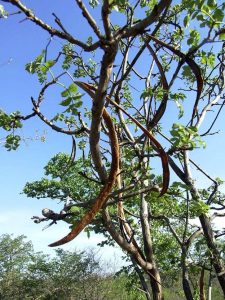
Markhamia acuminata. Photo: Bart Wursten. Source: Flora of Zimbabwe
In May we joined Ayrshire members at Dichwe Lemon Forest. This was especially memorable for your Chairman as Ma Hax insisted on behaving like a mountain goat while threatening imminent parturition. Less than 48 hours later my second and penultimate child, a daughter Jemima, was born. The “sensuous awareness which this forest invokes” (quote S.ST.J.D.) was quite something. The forest and the limestone hill overlooking it both provided the habitat for special trees like Gyrocarpus americanus, Albizia zimmermannii, Markhamia acuminata and Diospyros senensis.
The June outing to Bruce and Margaret Underwood’s property at Ruwa was of great interest as we saw true Parinari woodland. Not that it was without a great variety of woodland species. Of note were the many Grewia decemovulata, Maesa lanceolata and that Bequaertiodendron magalismontanum growing far from any river.
The July outing took us down Mariangwe Road, Harare South. Do you recall the Schotia brachypetala near which we saw Ehretia amoena? Remember the groves of Tarchonanthus camphoratus on Zengea Farm and the Euphoria cooperi encrusted hill side overlooking the new dam?
In August we travelled to Bushman’s Point and Lake McIlwaine Arboretum. Interesting to see the lake so low whereas now it is spilling. En route we saw the introduced Acacia caffra on the Old Gatooma road. Looking at Barbara Browning’s report I note especially Brachylaena rotundata and Tricalysia angolensis at Busman’s point. Our afternoon visit to the Arboretum we realized the good work that had been done years before to rescue and restore a decimated area. It was now back in a state of glory with little attention required. A considerable number of the introduced indigenous trees had done very well.
We were joined by a good number of Marondera members for our September trip to Ian and Jill Hunter’s Bornhill Estate, Marondera. Mundulea sericea was in flower and who can forget the sight of Ochna pulchra in glorious flower? Nor will I forget the Schotia brachypetala with so much nectar that one was drenched by the sticky rain if one stood below a shaken branch.
In October we again joined our Ayrshire friends at Ted and Ann Hatley’s Kyle Farm north of Banket. A morning climb on a kopje rewarded us with Olax obtusifolia, Albizia tanganyicensis, Trichilia emetica et al, et al. The all too brief exploration of the Caesar pass on the Dyke was still tremendously rewarding, Apodytes dimidiata, Rapanea melanophloeos, Phoenix reclinata, Ilex mitis, Ochna longepetiolata. This was followed by the memorable bus breakdown on the way home which, while the cause of some anxiety, was of considerable botanical interest and later afforded us the rare opportunity to enjoy the peaceful sounds of the bush at night under an unpolluted star filled sky.
Leily and Mary Henriques were our hosts in November for our trip to “New Erewhon” this side of Arcturus. An exciting find was the Philippia which could still turn our to be either P. hexandra or benguellensis depending on the flower which we did not see. The other special was the enormous Acacia sieberiana at the top of the hill, sheltering the whole ecosystem under its spreading boughs.
Copious rain was the catalyst that made our January outing a day with a difference. Our bus would not have made it down the farm road to our proposed venue at John and Stella Curtis farm, Keageri, so, undaunted, young and old alike walked the last 2 – 3 km. On arrival more excitement was provided as the more stout hearted boarded a fragile looking skip to sail over the swollen, brown river, suspended from a cable to reach the further shore. All that was missing was a seething mass of snapping crocodiles in the water below. The large numbers of Myrica serrata and Rhus quartiniana impressed me as did the Erythroxylum emarginatum on the banks overlooking the river.
The impossibility of reaching our proposed afternoon venue meant I was able to take members to Binga Swamp Forest which many had not seen before. I believe that the magnificence of the forest itself convinced members that the rescue operation in past years had been worthwhile.
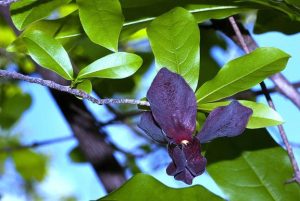
Monodora junodii. Photo: Bart Wursten. Source: Flora of Zimbabwe
Our last outing in February was to Aubrey and Edone-Ann Logan’s Golden Star Farm, Shamva. The weather dried up sufficiently to let us enjoy specials such as Maerua kirkii, Xeroderris stuhlmannii, Annona senegalensis, Monodora junodii, Millettia usaramensis, Bauhinia tomentosa, Dalbergia rovumensis and Holstia tenuifolia.
Happily our Botanic Garden walks have continued on a monthly basis under the most knowledgeable and entertaining leadership of the Director, Tom Muller, ably assisted from time to time by Bob Drummond, who I may say is invariably our saviour when it comes to identifying ‘strangers’ collected in the bush. Once again we concentrated on exploring families and the features which tie them together. We looked at ANNONACEAE, MONIMIACEAE, LAURACEAE, HERNANDIACEAE, FABACEAE (PAPLIONOIDAE), MORACEAE, CECROPIACEAE, RUTACEAE, OCHNACEAE, DIPTEROCARPACEAE, CLUSIACEAE, CAPPERACEAE, the Albizias within MIMOSACEAE, VERBENACEAE, BORAGINACEAE, LOCANIACEAE and the HAMMAMELIDAE. We did interrupt this routine, firstly to swot up on the Dichwe vegetation before going there and then to digress for a refreshing look at Low Altitude Rain Forest as an ecological unit.
The newsletter, Tree Life, has continued to form the cohesive base around which the Society operates. In the first place, the Calendar tells members what is going on and these write ups supply the feedback on what we have done and allow for revision in the likely event of arboreal indigestion. This is of course also most relevant for members who are not able to come on outings, walks, etc. The “Root note” department has been invaluable and we have been pleased to include an increasing volume of correspondence. I am indebted to Kim for his hard work with Botanic Garden write ups, many Rootnotes, editing etc. Barbara Browning has now done a good number of write-ups on the outings despite being told that the article is required yesterday, almost. Thanks. Thanks are also due to the representatives of the branches who take the time to send us write-ups and calendar material. It is nice to hear about different trees from those we are used to. I have probably neglected various other contributors so I say thank to all concerned.
Chegutu members have continued to hold outings during the past year and we look forward to joining them again. Keep it up, friends.
Stan Fourie and Gill Henderson are again in the driving seats at Ayrshire and are active with a recreational and educational conservation program. Matabeleland branch also continues to be most active, despite the sad loss of Dora Webb to Natal in August. Charles Sykes has kept us informed of outings in his role as Acting Secretary. Meg Coates Palgrave was able to join a couple of outings during the year.
Under the heading of Membership I have to report a drop in numbers, though not great. It is hard to give exact figures because of family and institutional members but we send out around 190 newsletters monthly which is perhaps 20 or so down on the last year’s figures. Departures from the country have taken their toll as have resignations. Often these come about due to inflation because people, especially pensioners, are unable to keep up membership with number of societies at once. Without embarking on a recruiting drive as such, it might be an idea to encourage interested persons to join us, for their benefit and ours and from the point of view of new blood, new ideas and perhaps also new directions.
Learner Groups. The learner group led by Gill Masterson have been less active perhaps than in previous years partly as a result of the drought, but also the lower numbers of learners, especially in the latter part of the year. However Gill remains keen to help learners and anyone interested should inquire direct.
Mukuvisi Woodlands have again had the benefit of George Hall’s membership on the Council. He continues to be the source of ideas and practical proposals.
Regrettably no new face has come up to take over Dick Petheram’s role regarding Binga Forest. So he has continued to at least monitor the situation. Fortunately the drought inhibited the growth of Mauritius thorn, but unfortunately it had an adverse effect on the legitimate inhabitants of the forest. Happily, Boy Scouts from the troop led by Mrs. Fiona Wilmot did some splendid work on the seedlings and it is hoped that this welcome source of help will continue.
In June our Vice President Kim Damstra, represented the Society at the Europe Environmental Bureau conference in Brussels and also visited the Men of Trees in England. The full report appeared in Tree Life no 60. Apart from the pleasure of the trip, meeting interesting people etc. the possibility of external finance for local projects exists.
The Committee has met on a monthly basis in a plush board room, by kind courtesy of Meg Coates Palgrave and her firm Stewart Scott and Partners. I thank the Committee for their time, effort, guidance, ideas and support. The happy atmosphere made the dull but necessary business less tedious, and helped restore equilibrium when the rare conflicts arose.
Once again I offer special thanks to Kim whose efforts as Vice Chairman have been immense. Without him to maintain momentum my own inertia would have ground me to a standstill and I wonder where the Society would have been. So from a personal point of view and on behalf of the Society, I wish to express our thanks to him.
When I agreed to stand as Chairman well over two years, and 24 Tree Lives ago, I was in a reasonably good position to be Chairman and had quite a bit of spare time to do it in. All that changed with the advent of Jessica, exacerbated by the arrival 18 months later of Jemima, and I have been conscious of the increasing difficulty of running and keeping up enthusiasm for the Society in the face of this competition and the consequent adverse effect on the Society. Feeding gaping mouths, changing nappies, bathing and reading Noddy aloud are not easily compatible with writing Tree Life or tussling with membership list etc etc. So I look forward now to getting back to my precious flute lessons, enjoying my family, and, not least, enjoying trees.
I wish the Society and my successor(s) well for the next year.
J.P.Haxen Chairman
LOWVELD GONA-RE-ZHOU TRIP, HEROES DAY WEEKEND, 1985
The idea of the trip was first voiced in Tree Life No 60 of February 1985. To recapitulate, though, we have been invited by the Lowveld Natural History Society to visit the Lowveld and in particular Gona re Zhou, with assistance from the National Parks people. Some assistance as been offered by way of transport, catering and camping equipment. The full plan has yet to gel and we will be liaising closer with our hosts on the details.
Meanwhile the proposal was put to members at the AGM. The response was good. The question really was whether to charter a 54 seater plane to Buffalo Range or to hire a 36, or more, seater bus with the advantage that this will give us some transport there and enable carriage of more kit. Fares at present quotes would be very roughly $105 – 115 by air as against $65 by coach.
We felt there was greater support for a coach trip. This would not preclude individuals from going by scheduled flights. The proposal adopted was to leave on Friday 9th August at midday, returning Monday 12th about midday giving us about 2.5 days on site.
We have about 25 names on our list and welcome more on a “first come, first served” basis. If over booking occurs we could perhaps get a larger coach. Booking will not be confined to members only.
For further information and bookings please contact Philip Haxen at P.O/Box 188 Harare or 27 Helensvale Road, Borrowdale, or phone 702561, or 8871413 home.
REPORT ON BINGA SWAMP FOREST, ARCTURUS
The forest was last visited two days ago, 15th March, 1985 with Secretary of the Arcturus Rural Council, Mr. Begemann.
We have managed to contain the spread and re-germination of Mauritius thorn fairly effectively during the past year, but, as always during the rains, it is “getting away” again in a number of places and will have to be tackled again soon.
There have been very heavy rains there of late and a lot of ‘wash; is visible in the minor gullies within the forest and in the major one outside it. We have been hoping for several years to do some reclamation work in these eroded areas, with financial assistance from the NRB, but the money has not been forthcoming, and indeed, we were informed in writing only a few months ago that none was available. It seems though, that very recently, there might have been a change of heart, or some loose change found in the bottom of the coffers of the NRB, and it is just possible that the Rural Council might be able to construct a few gabions across the gulleys, and bring in a bit of rock fill. If they can do that, it will be up to us to transfer some of the reeds from the forest to help in the stabilizing process.
The vlei on which the forest depends for its very existence, extends right through to Arcturus. Because of the drying up of boreholes in that area, an appalling amount of water is being siphoned from the vlei for mining and township purposes and for irrigation. If we are to save the forest it is imperative to retain some of that water to raise the rapidly deteriorating water table in the forest area. I have no doubt that the Rural Council will help all it can if the NRB plays its part, and I wish to record appreciation of the Council’s help with the access road and causeway and of the staunch support and help of Mr. Quenton Begeman, the Council’s Secretary.
-Dick Petheram,
ROOTNOTE : A beige, lambs wool cardigan with St. Michael’s label, was left behind at the Logan’s Farm, Shamva. Could the owner contact Dick Petheram, Harare 701153.
THE MAN WHO PLANTED HOPE AND GREW HAPPINESS – by Jean Giono
…continued from Tree Life No. 55 and 61
The oaks of 1910 were then ten years old and taller than either of us. It was an impressive spectacle. I was literally speechless and, as he did not talk, we spent the whole day walking in silence, through his forest. In three sections, it measured 11 kilometers in length and three kilometers at its greatest width. When you remembered that all this had sprung from the hands and the soul of this one man, without technical resources, you understand that men could be as effectual as God in realms other than that of destruction.
He had pursued his plan, and beech trees as high as my shoulder, spreading out as far as the eye could reach, confirmed it. He showed me handsome clumps of Birch planted five years before, that is, in 1915, when I had been fighting at Verdun. He had set them out in all the valleys where he had guessed, and rightly, that there was moisture almost at the surface of the ground. They were as delicate as young girls and very well established.
Creation seemed to come about in a sort of chain reaction. He did not worry about it; he was determinedly pursuing his task in all its simplicity; but as we went back towards the village I saw water flowing in the brooks that had been dry since the memory of man. This was the most impressive result of chain reaction that I had seen. These dry streams had one, long ago, run with water, Some of the dreary villages I mentioned before had been built on the sites of ancient Roman settlements traces of which still remained; and archaeologists, exploring there, had found fish hooks where, in the twentieth century cisterns were needed to assure a small supply of water.
The wind, too, scattered seeds. As the water reappeared, so there reappeared willows, rushes, meadows, gardens, flowers and a certain purpose in being alive. But the transformation took place so gradually that it became part of the pattern without causing any astonishment. Hunters, climbing into the wilderness in pursuit of hairs or wild boar had of course noticed the sudden growth of little trees, but had attributed it to some natural caprice of the earth. That is why no one meddled with Elzeard Bouffier’s work. If he had been detected he would have had opposition. He was undetectable. Who in the villages or the administration could have dreamed of such perseverance in a magnificent generosity?
To have anything like a precise idea of this exceptional character one must not forget that he worked in total solitude; so total that, towards the end of his life, he lost the habit of speech. Or perhaps it was that he saw no need for it.
In 1933 he received a visit from a forest ranger who notified him of an order against lighting fires out of doors for fear of endangering the growth of this natural forest. It was the first time, the man told him naively, that he had ever heard of a forest growing of its own accord. At that time Bouffier was about to plant beeches at a spot some 12 kilometers from his cottage. In order to avoid travelling back and forth, for he was then seventy five, he planned to build a stone cabin right at the plantation. The next year he did so.
. . . . to be continued


